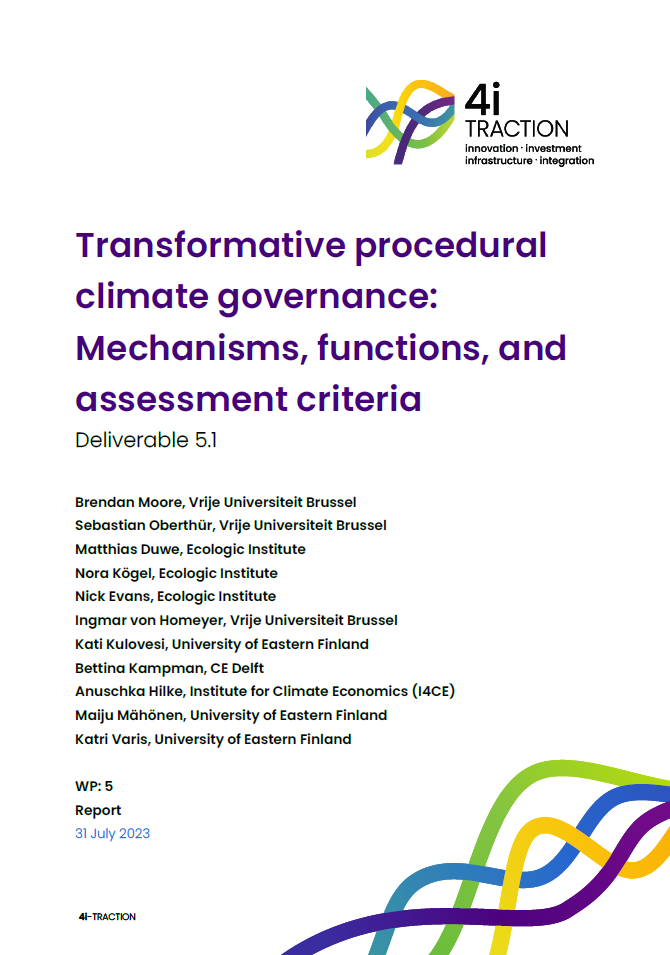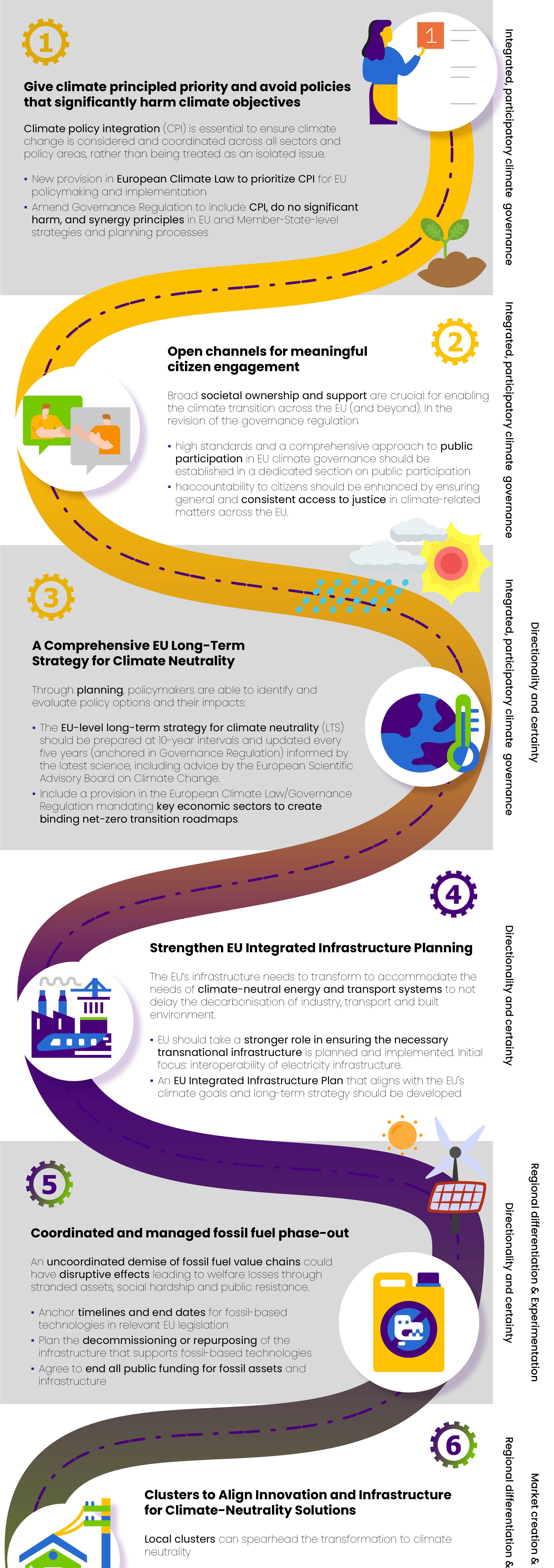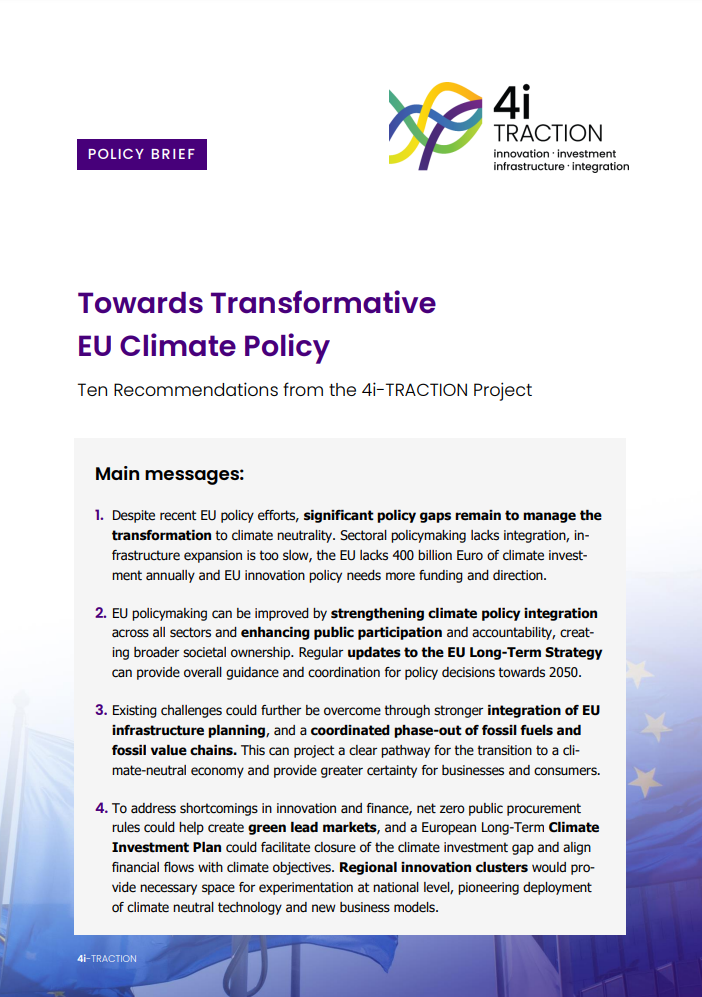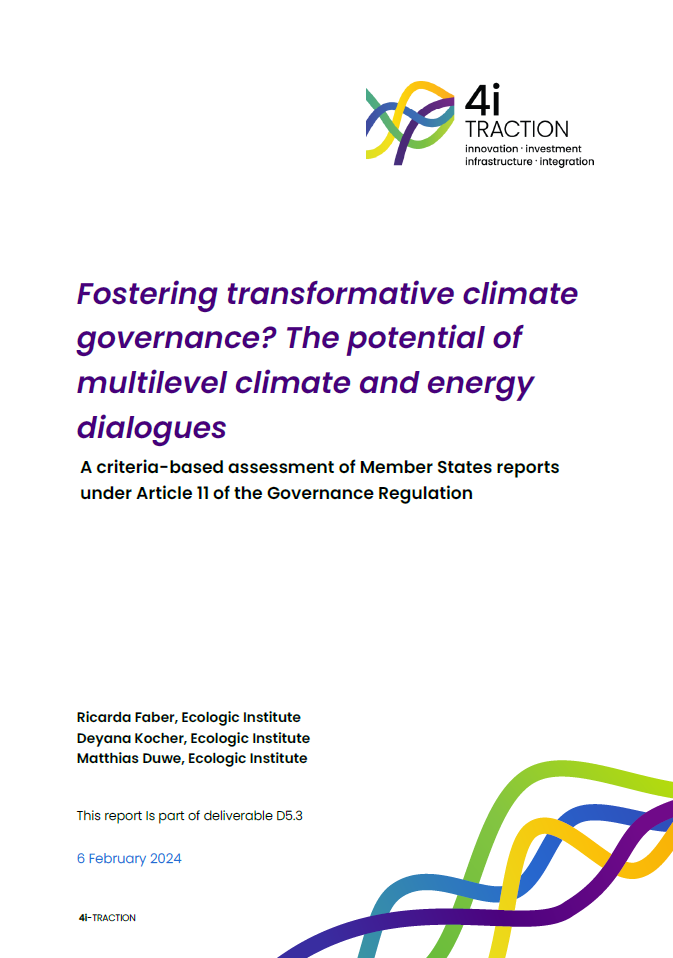Transformative Procedural Climate Governance
Mechanisms, functions, and assessment criteria
- Publication
- Citation
Moore, Brendan, Sebastian Oberthür, Matthias Duwe, Nora Kögel, Nick Evans, Ingmar von Homeyer, Kati Kulovesi, Bettina Kampman, Anuschka Hilke, Maiju Mähönen, and Katri Varis (2023): Transformative procedural climate governance: Mechanisms, functions, and assessment criteria. 4i-TRACTION Deliverable 5.1. Vrije Universiteit Brussel; Brussels.
This report focuses on the EU’s procedural climate governance, namely the frameworks, instruments and institutions that shape and support the climate-related decision-making process of the EU. Procedural governance plays a key role in the EU’s approach to the transformation toward climate neutrality: it aims to ensure that policymaking is well-planned, carefully monitored, subject to rigorous evaluation, informed by expert advice, and incorporates the positions of various stakeholders and the public. Although the EU’s procedural governance system has developed significantly in the past thirty years, it must be further strengthened to make the EU fit for climate neutrality by 2050.
The EU’s procedural governance architecture includes frameworks such as the European Climate Law and the Governance Regulation, procedural instruments such as the National Energy and Climate Plans, and institutions such as the European Scientific Advisory Body on Climate Change. Procedural governance works in concert with substantive climate governance, which directly reduces greenhouse gas (GHG) emissions and includes substantive instruments such as the Effort Sharing Regulation, the EU Emissions Trading System (EU ETS), the Renewable Energy Directive, the Energy Efficiency Directive, and the CO2 regulations for new cars, vans, and heavy-duty vehicles. Together, substantive governance and procedural governance constitute the EU’s approach to meeting its policy objectives and targets such as reducing GHG emissions 55% by 2030 compared to 1990.
Procedural governance is a key requirement for successfully reaching the hallmarks of transformative climate policy identified by Görlach et al. (2022). In that context, transformative EU procedural climate governance can be broadly defined as:
Procedural governance which actively facilitates the EU’s transformation toward climate neutrality and negative emissions by providing support for the creation, strengthening, and implementation of its substantive climate policy.
Procedural governance: frameworks, instruments, and institutions
In our approach, the overall concept of procedural governance is sub-divided into governance mechanisms, which we define as the individual components of the governance system that carry out its objectives. We identify three sub-types of governance mechanism: frameworks, instruments, and institutions.
- Frameworks are overarching governance mechanisms that structure how climate change policy and governance is carried out. Frameworks serve to create the overarching structure within which other governance mechanisms – instruments and institutions – operate. Examples of procedural governance frameworks include the European Climate Law, the Governance Regulation, and the European Green Deal.
- Instruments are the “the means that governments have at their disposal to address policy targets” (Hinterleitner et al., 2023, p. 3). Procedural instruments are those ‘tools of government’ which aim to affect how policy is formulated and implemented. Examples of procedural instruments include the National Energy and Climate Plans (NECP) and the National Long-Term Strategies (NLTS).
- Institutions are organisations that coordinate the processes and activities of the wider procedural governance system. Examples of climate governance institutions include the European Scientific Advisory Board on Climate Change (ESAB-CC) and the European Innovation Council (EIC).
Procedural governance functions
We take a functional approach to categorising procedural governance mechanisms, identifying eight procedural governance functions that they can carry out: target-setting, expert advice, planning, decision-making, implementation/enforcement, monitoring/evaluation, access to justice, and stakeholder participation.
Assessment criteria for governance mechanisms
We identify three criteria that we will use (as part of future research) to assess key procedural governance mechanisms within the EU climate governance system. Overall effectiveness relates to a mechanism’s ability to carry out its functions (such as planning or implementation) as well as the extent to which a mechanism has a transformative orientation. The latter means that it is designed with a transformative, long-term orientation towards climate neutrality/negative emissions and that it includes design features that promote long-term effectiveness. Policy resilience is a mechanism’s ability to maintain its coherence and adapt in the context of changing internal and external factors, such as changing political conditions (i.e., after elections) or the 2022 Russian invasion of Ukraine. Climate governance faces a complex and constantly evolving social, economic, and political context, making such policy resilience especially important. The quality of implementation examines whether a mechanism is implemented in a way that effectively moves towards climate neutrality, as well as the extent to which it is adequately resourced.









